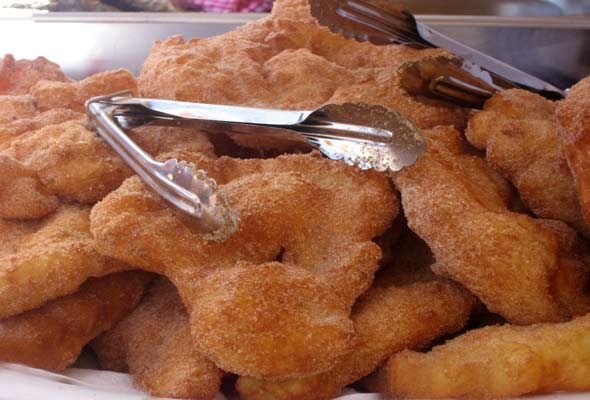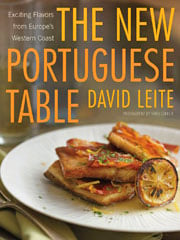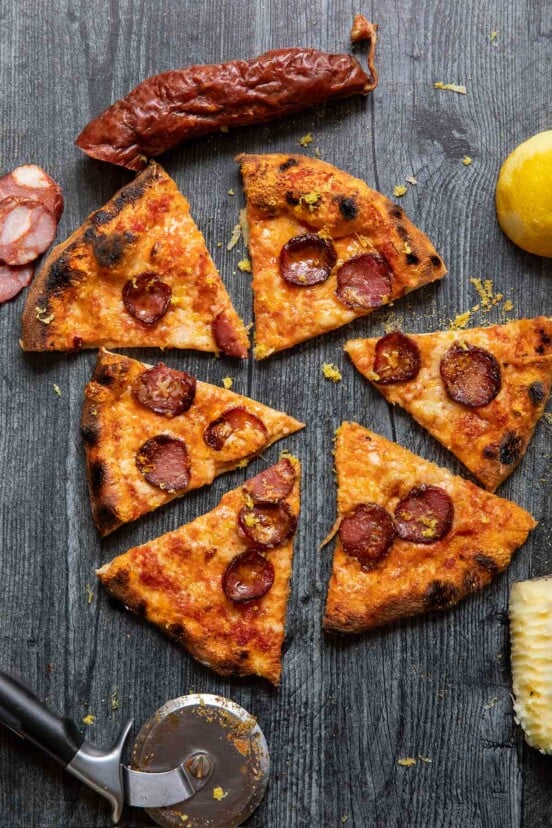
This recipe, adapted from the one my dad’s mom used to make in the Azores, has a flood of memories attached to it. I would sleep over at her house many a Friday night and on Saturdays she’d make these for my cousins, Fatima and Joe, and me. Hot out of the sugar-cinnamon bowl is the only way to eat them. In the Azores, some cooks shape these over their knees until they’re practically the size of lunch plates, just like my grandmother used to do. Others stretch and flop them out in their hands. I’ve made these smaller so they’re easier to work with, and fiddled with the recipe a touch, but beyond that, welcome to my childhood.–David Leite


Malassadas | Portuguese Doughnuts
Equipment
- Deep-fry or candy or instant-read thermometer
Ingredients
For the doughnuts | malassadas
- 1/2 cup whole milk
- 2 tablespoons unsalted butter, plus more for the bowl
- 3/4 teaspoon kosher salt
- 1 package active dry yeast, (2 1/4 teaspoons or 1/4 ounce)
- 1/3 cup plus 1 teaspoon granulated sugar
- 2 tablespoons warm water, 110°F (43°C)
- 3 large eggs
- 3 1/2 cups all-purpose flour, plus more for the work surface
- Nonstick cooking spray
- Vegetable oil, for frying
For the cinnamon sugar
- 1 cup granulated sugar
- 1/2 teaspoon ground cinnamon
Instructions
Make the doughnuts | malassadas
- Heat the milk, butter, and salt in a medium saucepan over medium-high heat, stirring frequently, until it just begins to steam and form bubbles around the edges, about 5 minutes. Remove from the heat and let cool until lukewarm.
- Meanwhile, in a small bowl, dissolve the yeast and 1 teaspoon sugar in the warm water. Let stand until foamy, about 10 minutes.
- In the bowl of a stand mixer fitted with the paddle attachment or with a hand mixer in a large bowl, beat the remaining 1/3 cup sugar and the eggs on medium-high until thick and luscious looking, about 5 minutes.
- Switch to the dough hook, add the milk mixture, the yeast mixture, and the flour, and mix on low speed until a soft dough forms, about 7 minutes, adding more flour if needed. The dough should be just slightly tacky but not sticky.
- Turn the dough onto a lightly floured work surface, shape into a ball, and place in a lightly buttered large bowl. Cover with plastic wrap and let rise in a warm, draft-free spot until double in size, about 2 hours.
- Lightly coat a 13-by-18-inch rimmed baking sheet with cooking spray and turn the dough onto the pan. Press and poke it with your fingers, much like making focaccia, to help stretch it until it's about 1/2 inch thick. Lightly coat the top of the dough with cooking spray, loosely cover the pan with plastic wrap, and let the dough rest at room temperature until double in size, 1 to 1 1/2 hours.
Make the cinnamon sugar
- Mix together the sugar and cinnamon in a shallow bowl.
Fry the doughnuts | malassadas
- Fill a medium saucepan with 3 inches of oil and heat over medium-high heat until it reaches 350°F (177°C) on a deep-fry or candy or instant-read thermometer. Monitor the heat to keep a steady temperature.
- Using scissors or your hands, cut or pull a 2-to-3-inch piece of dough from the baking sheet and stretch it into a 4-to-5-inch circle, then lower it into the oil and fry, turning frequently, just until golden brown on both sides and cooked through, 45 seconds to 1 1/2 minutes, depending on the size. Drain the doughnut on paper towels for 30 seconds and then toss in the cinnamon sugar. Repeat with the remaining dough. Devour warm.

Nutrition
Nutrition information is automatically calculated, so should only be used as an approximation.
Recipe Testers’ Reviews
I think I have a love for Portuguese desserts because I seem to try my hand at a different Portuguese recipe every Valentine’s Day. This year, I made these malassadas, and they did not disappoint!
The dough came together exactly as the instructions say. My dough was tacky to the touch. I made a mistake with the first rise and only let it go 1 1/4 hours…ooops! I guess I was overly anxious to get these in my tummy and I miscalculated the 2-hour rise. Regardless of that fact, my dough did continue to double on the second rise and these were a cinch to fry and coat with sugar. I bet if I let the first rise complete the full 2 hours, my malassadas would have been slightly more puffy and airy, but these were still really delicious and enjoyed by the family.
I used olive oil to fry these and they weren’t oily at all. I coated a half batch with plain sugar and a half batch with cinnamon sugar. They were both great.
I plan on making these again. Thanks to David for sharing his childhood recipe!



















This is essentially pizza dough, am I correct? Could these be air-fried like zeppoles?
Lee, it’s not a pizza dough. Pizza dough doesn’t have butter, sugar, and eggs in it. As to air-frying, I’ve never tried it, so I can’t say. But if you use the air-fryer, let me know how it turns out. Just be mindful it’s cooked all the way through. You want to make sure there’s no un- or under-cooked egg in it.
Can these be air fried?
Nanette, I’ve never tried them in the air fryer, so I can’t vouch for it. If you make them in the air-fryer, make sure they’re cooked all the way through. You don’t want to eat undercooked eggs.
Thank you for this wonderful recipe! These are so easy to make, and always turn out so perfect. The whole family practically devours the batch as soon as I make them! (My son even requested I make them for a dessert for his school’s Ancestor Picnic – celebrating his Portuguese Heritage. Yay!)
Nicole, that’s a high honor indeed! Thank you for your kind words. Please give your son and his fellow picnic-goers my best.